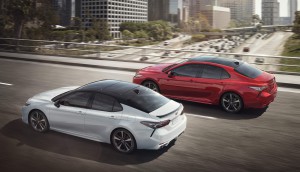
Toyota EVP Bob Carter (left) said the automaker plans to add 100,000 trucks and SUVs to its production rolls this year to meet demand.
Toyota plans to build an additional 100,000 trucks and sport utility vehicles this year to meet rising consumer demand, Bob Carter, Toyota executive vice president, told the NADA-J.D. Power Automotive Forum on the eve of the New York International Show, but it’s not giving up on cars.
Carter stressed that Toyota isn’t about to give up on the midsize passenger car segment, which remains one of the largest segment in the industry despite three years of decline that continued during the first quarter of 2017.
Toyota has sold about 10 million Toyota Camrys over the years and is preparing to launch a new version this year. The preparations for the launch of the next generation Camry are one of the reasons that Toyota confirmed once again this week it plans to invest of $1.3 billion in the company’s manufacturing complex in Georgetown, Kentucky.
As part of the investment, Toyota plans to build a new paint shop at the Georgetown plant. Carter noted that one of the reasons contributing to the decline in the sales in the midsized passenger car segment is the dearth of new product.
(Toyota trying to appeal to millennials with FT-4X Concept. Click Here for the story.)
“If you look at the Camry, the Accord, the Fusion the Malibu they’ve all been around for a while,” he said.

Toyota designers were looking to add to excitement to the new Camry for 2018 as the maker remains committed to the "car" segment.
Mark Reuss, GM executive vice president made the same point last week, when GM took the wraps of the next generation of the Buick Regal, which is due out next fall. “There hasn’t been much new product in the segment,” Reuss said.
(Click Here for details about Toyota’s $1.33 billion investment in Kentucky facility.)
Carter said the introduction of the new Camry will help change perceptions of the segment. Honda is also planning to bring out new version of the Accord, which has traditionally been the chief competition for the Camry.
Coming out of the Great Recession, the car-truck split was roughly 50-50. However, the shift has been dramatic since then and the car truck split has moved to 65-35 in favor of trucks and SUVs. Consequently, Carter said, “It will go higher.”
(Is This Concept Toyota’s Answer to the Ford Bronco. To find out, Click Here.)
As a result, Toyota expects to increase its production of trucks and SUVs by 100,000 units he said.
